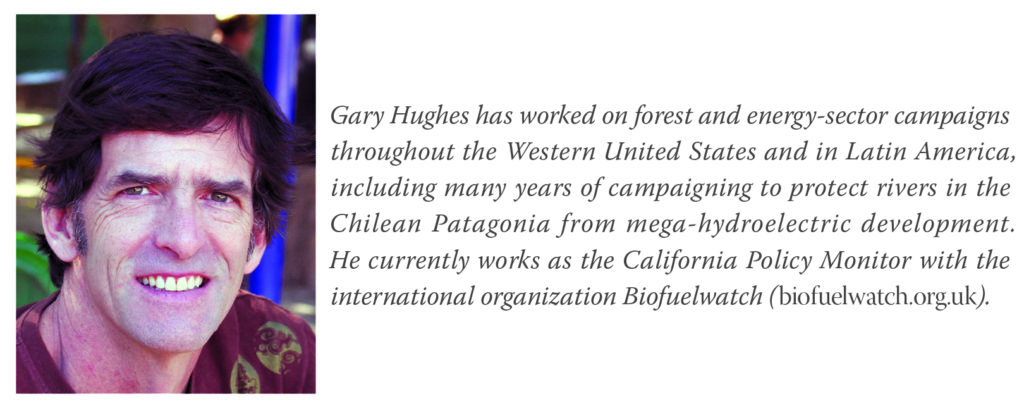Activist Corner
Fifteen Years and Counting: Time to Lift the Veil on Carbon Markets on the North Coast
By Gary Graham Hughes
“I am not interested in learning where the money comes from, I don’t have time. I just need to focus on my work.”
These words were spoken by a long-time forestry professional with extensive experience on the North Coast and throughout California when I asked about a perspective on the ramifications of relying on project funding made possible by the state-managed revenues of the cap-and-trade program.
Such a dismissive attitude about the nuts and bolts of the carbon market seems out of place, if only because billions of dollars of annual revenues are being generated by the mechanism—funding that land-management practitioners are coming to rely on extensively.
This disinterest in the rules of the market was amplified by an admitted lack of knowledge about the history of the program, the legislative maneuverings, the agency politics, the industry giveaways, the market volatility, the failures to reduce real-world greenhouse gas emissions, or the multitudes of environmental-justice controversies that surround the mechanism.
It’s a sobering reality that the cap-and-trade program, now more than a decade in existence, remains a near total enigma to most people. This program is directly connected to climate pollution from refineries in the state, but even environmental proponents deeply involved with forest carbon-offset projects (or who receive cap-and-trade generated grant funding from the state) may not know this basic fact. Many years after invention of the forest carbon-based offset commodity—by far one of the more controversial elements of the infamous California cap-and-trade program—there are still multitudes of environmentally active people on the North Coast who have very little understanding of how the market works or the role of the program in California climate planning.
This lack of knowledge has ecological, political, and ethical implications. To begin to construct a foundation of understanding and a vocabulary of the basic civics of these climate policies, it is necessary to do a rudimentary review of the beginnings of the main frameworks of California climate policy.
The Global Warming Solutions Act
The cap-and-trade program has its roots in the Global Warming Solutions Act of 2006, the celebrated AB 32 that was signed into law by Governor Arnold Schwarzenegger and that heralded the beginning of the era of California’s
self-designated national and global climate leadership.
The Global Warming Solutions Act gave authority to the California Air Resources Board to design and implement a variety of measures to drive down greenhouse gas emissions in the state. Though AB 32 gave rise to many policies, for ease of explanation there are three main frameworks arising from AB 32: the Renewable Portfolio Standard; the Low Carbon Fuel Standard; and the markets-based compliance mechanism, better known as cap-and-trade, and officially titled the Western Climate Initiative, Inc.
The Renewable Portfolio Standard (RPS) is responsible for a very significant shift in electricity generation towards sources like solar energy. Regardless of the documented environmental impacts from utility-scale generation resulting from industrial solar installations in fragile desert ecosystems, or the consideration by the RPS of dirty energy sources such as biomass energy as renewable, the RPS has been without question the most effective of the three frameworks in successfully reducing greenhouse gas emissions.
The Low Carbon Fuel Standard (LCFS) is a little known and complex mechanism, opaquely designed to ostensibly lower the “carbon intensity” of liquid fuels like gasoline and diesel that are used in the state. The LCFS is a market-incentives mechanism that assigns all liquid fuels a carbon intensity score. All liquid fuels are compared to a baseline score that determines if a fuel earns credits for being below the baseline or debits for being above the baseline. Liquid fuel manufacturing and distribution interests participating in the market need to buy or sell LCFS credits to balance their accounting sheets to attempt to meet overall annual carbon
intensity requirements.
Credits for LCFS can be earned in multitudes of ways, from building electric vehicle charging stations to the contested development of dairy digesters looking to monetize the methane pollution from industrial animal agriculture operations.
It is the allure of big money in the LCFS that is one of the motivating factors for the push of petroleum refiners Phillips 66 and Marathon to repurpose their refineries in the SF Bay Area to produce supposedly “low carbon” diesel and jet fuels from high deforestation-risk commodities like soy. It is the LCFS that has also given birth to head-spinning credit-generation opportunities like using solar- powered water-heating technology for oil-drilling applications like fracking, and to thus extract a supposedly solar-powered “lower carbon” crude petroleum.
But the crown jewel of California markets-based climate policy remains the cap-and-trade program. Legally rooted in the passage of AB 32 in 2006, in 2017 the state legislature and Governor Jerry Brown worked with the oil industry and pushed legislation through to extend the market out to 2030.
What was remarkable about the 2017 cap-and-trade extension, despite the fact that it was opposed by every environmental-justice organization in the state, is that the market mechanism was elevated as the sole legal mechanism in the state for regulating the carbon dioxide emissions from refineries and other large “stationary sources,” effectively pre-empting the authority of local air districts to cap or reduce emissions from these polluters.
These large sources of emissions are responsible for upwards of 85% of the industrial climate pollution in the state.
Disturbingly, emissions inventory data from the Air Resources Control Board show that since the beginning of the carbon market, refinery emissions have largely stayed the same or even increased.

California Climate Investments
At the same time, billions of dollars of revenue have been raised by the state through the sales of the allowances that give the polluter permission to pollute, and to meet the requirements of the market, even as real-world emissions fail to come down.
These revenues are distributed through the Greenhouse Gas Reduction Fund or, as the Air Resources Control Board calls it, the California Climate Investments program. This is the money that many natural resource professionals in Northern California are currently relying on for grant support from the state for their projects.
Forest Carbon Offsets
Another permit to pollute available to the facilities covered by cap-and-trade are offsets. On the North Coast the sale of forest carbon offsets has become a staple of industrial forest-management practices. Unfortunately, despite their increasingly common utilization by interests around the region, the actual economic and regulatory mechanics of offsets, and the fact that their sale is connected to fossil fuel pollution, are largely obscured from view.
Lifting the veil on carbon markets on the North Coast is going to require a combination of courage, education, transparency, and accountability.
Whether you are in support of the market because of the funding it provides for achieving your land-management objectives, or whether you have concerns because of the dubious climate science and environmental injustices, there is no question that it is long past time for stakeholders in the redwood region to learn about how these market mechanisms function, about who benefits, and about who shoulders the cost.
Fifteen years after the passage of the Global Warming Solutions Act, this seems like as good a time as any to start a long-overdue crash course in California climate politics.

